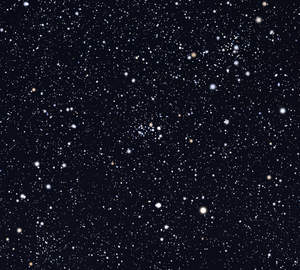NGC 7790

|
|
| NGC 7790 (middle), NGC 7788 (ro) | |
| AladinLite | |
| Constellation | Cassiopeia |
|
Position equinox : J2000.0 |
|
|---|---|
| Right ascension | 23 h 58 m 24.2 s |
| declination | + 61 ° 12 ′ 30 ″ |
| Appearance
|
|
| classification | III2p |
| Brightness (visual) | 8.5 likes |
| Angular expansion | 5.0 |
| Physical data
|
|
| distance | 9600 ly (2944 pc ) |
| diameter | 14 years |
| Age | 55 million years |
| history | |
| Discovered by | Wilhelm Herschel |
| Discovery time | December 16, 1788 |
| Catalog names | |
| NGC 7790 • C 2355 + 609 • OCl 276 • Cr 461 • GC 5032 • H VII 56 • h 2285 • | |
NGC 7790 is a type III2p open star cluster in the constellation Cassiopeia in the northern sky . It is about 9600 light years from the solar system, about 14 light years in diameter, and about 55 million years old.
It is possible that it forms a double cluster with NGC 7788 , which is about a quarter of a degree to the northwest.
The object was discovered on December 16, 1788 by William Herschel .
Individual evidence
- ↑ NASA / IPAC EXTRAGALACTIC DATABASE
- ↑ a b c SEDS : NGC 7790
- ^ A site Devoted to Stellar Clusters in the Galaxy and the Magellanic Clouds
- ↑ Seligman